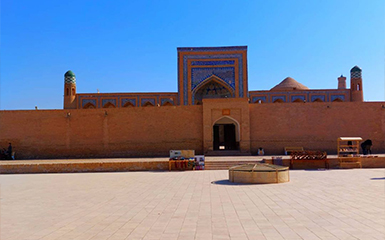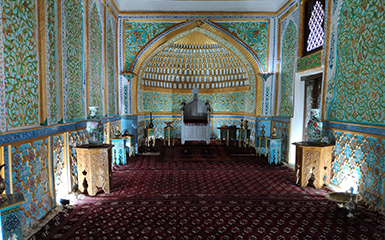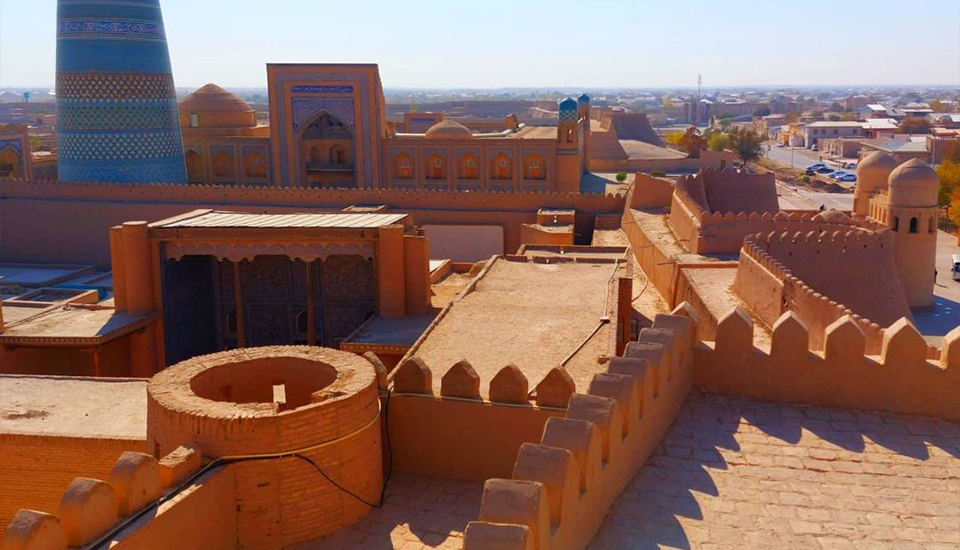Bahauddin complex
Char Minar
Lyab-I Hauz complex
Poi Kalan complex
The Ark Citadel
Bolo Haouz Mosque
Kalan Minaret
Islam Khodja complex
Itchan Kala
Kalta Minaret
Kunya Ark
Kutlugmurat Anak
Alla Kuli Khan
Muhammad Rahim Khan
Muhammed Emin Khan
Pahlawan Mahmud
Tash Hauli
Juma Mosque
Andijan
Muynak
Rabati Malik
Itchan-Kala (Inner Fortress) is the historic city centre (Shahristan) of the Uzbek oasis city of Khiva, surrounded by a city wall. In 1990 Itchan Kala was included in the UNESCO World Heritage List as a World Heritage Site.
Khiva is said to have served the caravans as a rest stop in ancient times and was already surrounded by a wall in the 6th century. Khiva is mentioned as a city in the 10th century. Due to its location in the oasis landscape of Khorezm south of the Amu Darya on the edge of the Karakum desert, the city profited from trade and was a transhipment point for the caravans that moved through the desert to Persia or came from it. During the Mongol storm, the city was conquered by Genghis Khan's troops in 1220 and largely destroyed; another Mongol conquest of the rebuilt city came in 1388 by Timur.
At the beginning of the 17th century, instead of Gurganj, Khiva became the capital of a khanate founded in 1511 by a side-line of the Uzbek Shaybanids, which has since been referred to as Khanate Khiva. In 1740 the Khiva was conquered and destroyed by the Persian Shah Nadir and the Khanate Khiva became part of the Persian Empire for a short time. In 1785 the reconstruction of the city wall began. In 1873 the khanate became a Russian protectorate, but formally continued to exist until 1920, when it was occupied by the Red Army during the Russian civil war.
The cityscape of Itchan Kala, the historic old town of Khiva, is predominantly characterized by buildings that were built in the 18th and 19th centuries after the city was destroyed by the Persians, even if some older buildings still exist. The roughly rectangular old town extends over an area of about 400 × 720 meters and is surrounded by a wall about 2.2 kilometres long and about 7 to 8 meters high. A gate leads into the old town on each side of the rectangle.
The world heritage site covers an area of 37.5 hectares. Its border essentially follows the city wall, but also includes a small area outside the city wall southeast of the Alla Kuli Khan Madrasah with the Said Shaliker Bei complex.
Even if the entry as a World Heritage Site was not made on the basis of individual buildings, but rather on the basis of the overall appearance of the city, some individual buildings and building ensembles are particularly emphasized in the summary of the decision on the entry.
Among them are the Djuma Mosque at mosques, which was built in the 10th century and rebuilt from 1788 to 1789, as well as the Ak-Mosque (1675), at madrasas the madrasah Muhammad Rahim Khan, the madrasah Alla Kuli Khan and the Madrasah Muhammad Amin Khan, at mausoleums the Pahlawan Mahmud memorial, the Said Ala ad-Din mausoleum, caravanserais and markets as well as two palaces that were built by Khan Alla Kuli at the beginning of the 19th century.


